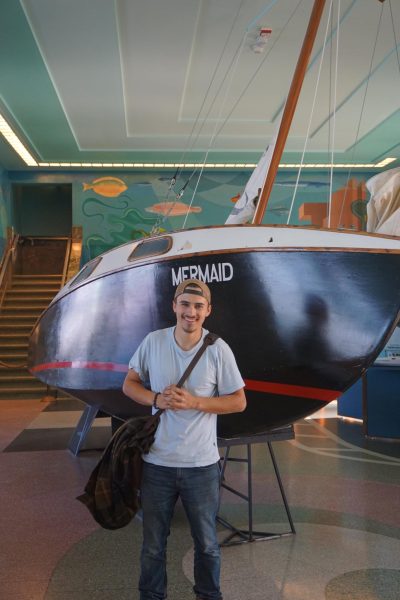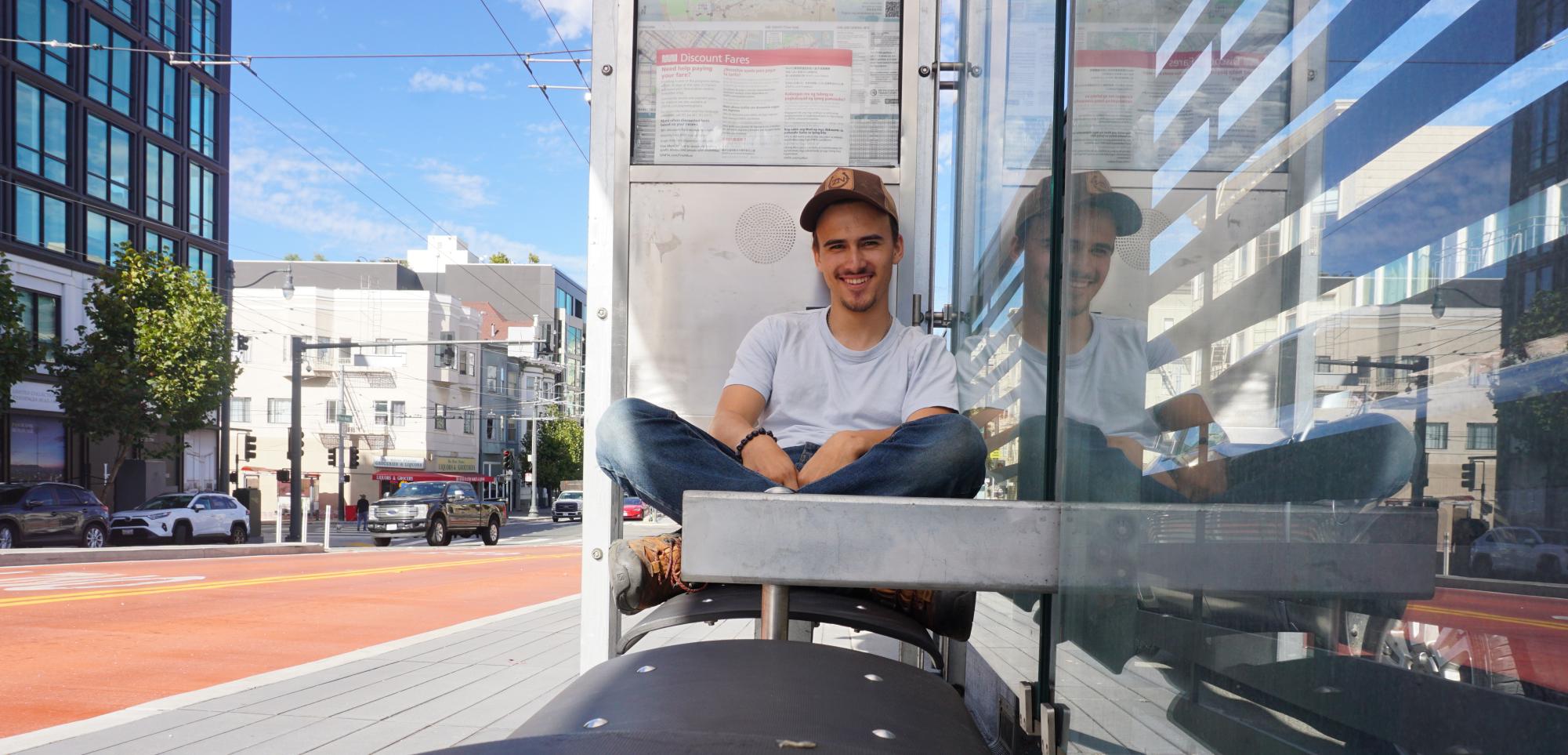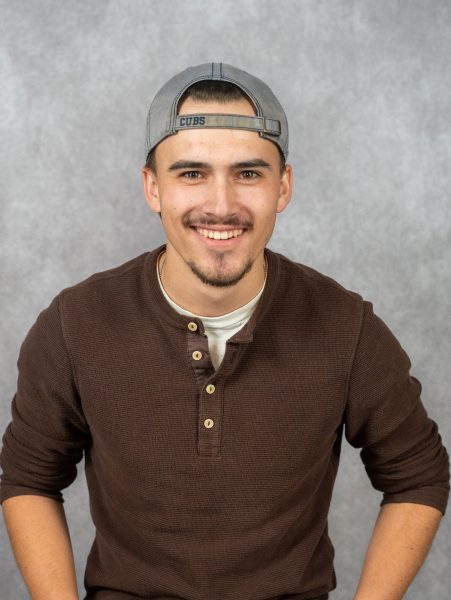Kerouac and his debauched companions hitchhiked and drove to Colorado, Twain explored the heart of America as a pilot on a Mississippi riverboat, and we — well, we at Santa Rosa Junior College have the bus and the SMART train. This doesn’t scream freedom and rebellion against the militaristic mores of a postwar culture, but they are ours.
SRJC students ride free on local Sonoma County buses with a school photo ID. That won’t take them far enough for an epic journey, not even far enough to get to San Francisco, but it gave me a way to frame a quest I make each year.
In 1962, 23-year-old Kenichi Horie sailed his 19-foot sailboat Mermaid from Japan to San Francisco. He sailed without a passport, crew or more than a few words of English; after making landfall he was briefly arrested, then given a 30-day visa and the keys to the city.
His ethos as an everyman Odysseus has inspired me as a person and a sailor since I first read his book, “Kodoku: Sailing Alone Across the Pacific,” in ninth grade. Mermaid is kept in the San Francisco Maritime Museum, and I try to make a pilgrimage to go visit her at least once a year.
This year, to visit Mermaid, I planned to ride the train and the bus for a day, from Sebastopol to San Francisco and back. I wanted to see how workable our much-maligned American public transportation system was, but also to see what kind of adventure I could fit into an empty Friday afternoon.

I was self-conscious of the thesis. Normal people ride public transit everyday all across this country, and I was hesitant to convey that normal experience as exotic. Strangeness wasn’t the point; my goal was simply to see if, by doing something a little bit different, I could get a new perspective on a trip I’d only ever made before in my 2007 Toyota RAV4.
It felt right, felt exciting, to not have the option to escape by car as I stood and stamped my feet in the cold at the bus stop. I’d trapped myself here, at the corner of Morris and Hwy 12, and being trapped like that, felt a little more free. The region was familiar, but without the autonomy of a car I was more reliant on my wits, a little less secure. That feeling gave my morning a sense of meaning.
On the ride from Sebastopol to Santa Rosa, I sat next to a man wrapped in a brown duvet and big straw hat who went by “Jeff.”
Jeff pretended to smite the cars in front of us with an imaginary hammer of immense proportions. He talked like Popeye, his words all full of hard consonants and mumbles. “Smash! I won’t let you get ahead of us, nuh-huh,” he said, his arm swinging wildly at the semi-truck in front of us.
Jeff told me he was from Novato and that he had come up here to see a friend. I think he was on his way home, but I didn’t understand most of what he was trying to say.
Held up in traffic, we looked out over the congested Hwy 101. He turned to me and pointed a dirty finger at the jam of commuters inching into Santa Rosa.
“Look at that panoramic view, it’s beautiful!” he said.
I agree. It was, in a way, a beauty.
I’m distrustful of Google Maps’ suggestions for public transportation. The App lacks a certain human logic. It doesn’t understand that I’d rather walk than wait and that I’d rather wait than pay $50 to ride an airport shuttle. To emphasize my humanity, I resolved to use it as little as possible.
I knew that the SMART train was in Santa Rosa and that it would take me south. That was enough to start.
I left the bus in front of the Santa Rosa city annex and walked to the SMART station, put $15 on my blue Clipper Card, and went to talk to the docents at the Santa Rosa Train Station visitor’s center while I waited for my next ride.
Docent Pam Higgens greeted me when I wandered in. Sitting behind the information desk amid maps and brochures along refurbished rustic wood walls, she was quick to wax philosophical about the role she served in helping the less fortunate travel.
“Here’s the problem: buses should stay low-tech,” Higgins said. “What about people who just have a flip-phone, or no phone at all? Those are the people who need the bus most of all.”
Higgins’ job, as she saw it, was to be an advisor for those people, be they travel on a city bus, Amtrak or the train.
Her sense of purpose was heartwarming. On leaving, Higgins’s coworker Deniese pulled me aside. “Look, if you ever need travel advice, Pam is your girl,” she said conspiratorially.
Compared to the Sonoma County Transit bus, the SMART train fosters an atmosphere of greater fortune, either because the business caters to Bay Area commuters with grandkids and salaried jobs, or because the institution of permanent rails and panoramic vistas of swampy cow pastures attracts the confidence of those less willing to forsake four wheels.
Instead of stolen mountain bikes strapped to the prow of a city bus, elegant carbon fiber mounts hang by their front wheels inside the air-conditioned train, and the interior is sterile and plastic instead of stinking of piss in purple carpet seats.
I relaxed and took in the atmosphere.
Across from my seat, the conductor asked two older women in straw hats and purple quilted vests to show him their IDs. SMART started a pilot program in August, letting youth and seniors ride for free.
“I gotta make sure,” the conductor said to the two women as one of them fumbled for her driver’s license. “You could just be really good makeup artists.”
“Nah, that’s just how old I’ve made her look with all of my nonsense,” one of them said about her companion. They all laughed.
For me, the ride cost $6.
I got off in San Rafael. I could have kept pushing south to Larkspur, but I wanted to stay on the more egalitarian highways instead of tearing across the Bay on a ferry.
As I stood on the platform, a panhandler with bright blue eyes came up to me. “Give me some money. I need to buy a little food, brother,” he said. There was something monk-like, almost saintly about the way his unkempt hair reached his shoulders while the top of his head was bald and sunburnt.
“Sure,” I said, and reached into my pocket. “I’ve got a couple bucks, but only in quarters.” I’d taken my collection of spare change to pay the bus fare, and I was hoping I could hear his story.
“Forget about it man, forget about it! I don’t need to take shit from you.” Instead of trying to pull the fistfull of coins out of my jeans pocket, I looked at him puzzled.
“So, where are you traveling to?” I said. He just shook his head at my bourgeoisie barbs and stormed off.

The Golden Gate Transit bus 101 took me across the Golden Gate Bridge and into San Francisco’s Marina District for $8.50. This left me with 50 cents on my Clipper Card and an unknown sum of quarters jangling in my pocket as I walked onwards.
I got off the bus a short distance away from the Exploratorium, and stood blinking in the sun and wondering how I would pay for the last bus, the last link in my pilgrimage.
San Francisco is and has always been “The City” to me, but standing on the sidewalk without a car, a plan or an obvious way to pay for my next ride, I felt exposed to a ridiculous degree.
Saint Augustine said, “It is solved by walking.” Solvitur ambulando in Latin. I elected to trek the last mile to the Maritime Museum instead of figuring out how to reload my Clipper Card.
Those who wish to ride would be wise to travel in hiking boots.
An older man in a blue tracksuit washed a silver Porsche with a black pistol-grip hose nozzle outside his peach-colored apartment, and I stepped into the street to avoid the suds.
After making my final approach to the Mermaid herself, I learned from the Maritime Museum docent that Kenchie Horie’s fame has grown overseas. She sees more Japanese tourists coming to see the Mermaid than Americans.
“They’re reserved, you know, very polite,” she said. “And then they see Mermaid and just freak out.”
I stood there, looking up at the modest black plywood boat for a moment. “My entire youth was spent in conversation with her,” Horie had written on a commemorative tray, presented to the museum when he donated the boat. I keep coming back to look at the Mermaid, I think, because of that commitment and connection to an idea, an adventure, a quest.
I had my picture taken, thanked the docent, and then turned to catch the next series of buses home. I walked to a small hardware store to put another $15 on my card and rode a series of buses back toward Sebastopol.

The bus was almost quiet, lumbering through the afternoon traffic jams. In front of me, two gray suits bragged about the millions of somebody else’s dollars their bosses managed.
Behind me, a man rolled on the floor at the back of the bus, muttering nonsense to himself.
Before we pulled into Cotati, this man dragged himself over to me and asked if he could make a call on my phone. His face was lean, his hair cut short, and he wore a faded shirt from some mechanic’s shop in Oakland. His arms, clutching at my seat, were red with a rash that he kept scratching. “My phone got stolen, buddy. I can’t believe they stole it, and then they broke it,” he said.
At his suggestion, I dialed the number and held the phone out to him. It was his mom. She asked why he was late. He snapped back that he would be home soon. She sighed. He said goodbye.
I never asked his name, but as we rode through the suburbs of Cotati, he pointed out his street to me. “I wish there was a bus stop here,” he said. It was a terrifyingly normal neighborhood; normal in the same way his mom had sounded through the speakerphone.
For the first time, the trip felt tied to forces greater than I had expected.
I rode the bus to the Maritime Museum in San Francisco to pay homage to a great sailor. Through that pilgrimage, I was looking to see if I could fit into an ordinary Friday some part of that ethos those adventurers and writers I admire found at sea or in the cars of strangers.
I would still ride with Dean Moriarty. I still plan to sail like Kenichi Horie. But that feeling of loneliness and exposure and the texture of life itself was out there, on the bus.
I would gladly ride it again.





